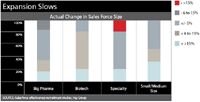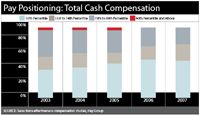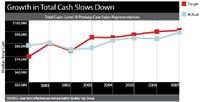Salesforce Survey 2008
Pharmaceutical Executive
Welcome to the new employer's market for reps. The Hay Group's annual survey reports how, as the primary sales force contracts, so too does its pay.
Like a giant steam vent on a pressure cooker, the law of supply and demand has finally relieved the pressure pharmaceutical companies have felt for the past 10 years from ongoing pay inflation. Enough large pharma companies are downsizing their primary care sales force that it is now becoming an employers' market for qualified primary care reps.
For the first time in more than a decade, the sales force "arms race" has halted. Salaries appear to be leveling off, and pay practices are likely to be less aggressive in the immediate future. If this trend continues, it will have a ripple effect on hiring practices and pay structures. Companies will have the luxury of attracting talent in an environment with lower pay inflation and of choosing from more qualified candidates.
These were some of the findings of the Hay Group's 17th Annual Sales Force Effectiveness Study. (See "About the Survey," left.) However, not all companies—and not all positions in sales and marketing—are experiencing the same loss of prominence as Big Pharma's PCP field reps. In particular, Big, pharma is rethinking its sales force structure and investing in areas like managed care and national account management, which can have a greater impact on sales.
All these changes show that the pharmaceutical industry recognizes it's living in a new world—but that a tightening of the belt, when it comes to sales forces, may be just what the doctor ordered.
Hiring: On the Downhill Slope
For the first time in more than a decade, the pharma industry has halted its sales force expansion. In 2007, thousands of reps were hit with pink slips in a much-publicized spate of downsizing.
Of the Big Pharma companies responding to the Hay Group survey, 17 percent have decreased their sales staff by more than 15 percent. This precipitous drop is particularly telling because launch activity—the main driver of sales force ramp-ups—has been steady for the past five years. These major layoffs from Pfizer, AstraZeneca, and others made headlines and indicate major shifts within the industry. But they don't tell the whole story.
Half of all Big Pharma companies reported no significant change at all in the size of their sales force. This is somewhat a function of product pipeline and somewhat related to their focus on specialty products. Meanwhile, if one looks across the spectrum of company types, there are still pockets of growth. Half of all Hay Group survey respondents increased the size of their sales force by 6 percent or more in the past year. The highest growth rate (22 percent) was among hospital sales reps, reflecting the continued emphasis on reaching larger provider groups and specialty products. (See "Expansion Slows,")

Expansion Slows
As is expected in a climate of major layoffs, the rates of voluntary turnover—when the employee decides to terminate his employment by a company—have also declined. Voluntary turnover was 12 percent in 2007, compared with 15 percent in 2006. This is, however, still a bit higher than the 10 percent we see in sales positions in other industries. The most movement is typically among PCP reps, but interestingly, for the first time, voluntary turnover among PCP reps, hospital reps, and specialty reps was the same. Hospital and specialty reps have begun gravitating toward smaller or midsize companies with more robust pipelines. We are seeing that many of these reps are willing to accept lower pay in exchange for perceived greater job security—a big concern, given that only 17 percent of Big Pharma companies anticipate growth in the next 12 months.
Even though turnover rates are coming down, the length of time it takes to fill vacant territories has increased, which means that many companies still struggle to stay fully staffed. One quarter of participating survey respondents report an average vacancy rate of more than two months. Filling open sales positions is particularly problematic for biotech companies, where a whopping 60 percent report an average vacancy rate of more than two months. This difficulty is likely due to the greater selectivity many biotech companies use to recruit specialty sales talent.
There's no doubt that companies are learning to do more with less. Key to that is trimming the fat while retaining top talent. The numbers back this trend: More organizations are implementing formal processes for retaining high-performing and high-potential salespeople. This year, 41 percent indicated that they have a formal process in place, compared with 30 percent in 2006 and 22 percent in 2005. This process may be as simple as identifying high-performers and communicating to those reps that the company views them in this way. In any case, companies are rapidly realizing the importance of this process to keeping their strongest field reps.
The use of contract sales organizations has not abated, as organizations are taking advantage of the greater flexibility offered by outsourcing. One-fifth of the responding companies use contract sales organizations, consistent with 2006. However, the industry is less likely than in the past to recruit these workers into full-time staff positions. In 2006, all companies said that they occasionally recruited contract staff, whereas this year, only 75 percent did (likely a result of downsizing and the redeployment of internal sales staff). That being said, many companies are, in fact, increasingly open to hiring sales people with no industry experience; this year, 69 percent of participants said they did so, compared with 56 percent in 2006.
Base Salary: Aiming for Average
The shift to an employers' market was evidenced by the stagnation of primary care reps' salaries. In 2007, the median base pay for all reps was $63,100, up from $61,900 in 2006 (a 1.9 percent increase). The median total compensation for a Level II primary care sales rep—that is, a fully trained sales representative—was $96,500, up from $94,500 in 2006 (a 2 percent increase).
Pharmaceutical sales reps continue to be paid more handsomely than their counterparts in general industry, where median base salaries for sales reps are $62,000 vs. the $72,100 average for all types of pharmaceutical reps.
However, the average merit increase did not change between 2005 and 2006, and at 4 percent was slightly above that of general industry's 3.5 percent. Given the freer labor market, it is very likely that merit increases will begin to level off, if not decrease, as companies will not need to pay a premium to attract and retain the talent they need.
This trend is not yet true of total cash compensation for specialty reps, as they continue to experience pay increases.
Putting aside specialty sales, there are apparent changes in the way that companies are targeting their pay scales in relation to the market. Most companies set out to pay reps at or above the market median. Therefore, since no company targets below the median, the median is a constantly moving target, and has had the effect of ratcheting up pay levels and inflating reps' salaries. (See "Pay Positioning: Total Cash Compensation," ) But this year, companies have begun to target lower overall, with no pay packages targeted above the 90th percentile. This is a continuation of a trend, where the number of companies targeting cash compensation in the 75th to 89th percentile has shrunk 50 percent in the last four years.

Pay Positioning: Total Cash Compensation
Incentive Compensation: Too Much at Risk?
In 2001, incentive compensation accounted for 20 percent of a salesperson's total compensation. Over the next several years, that percentage rose gradually as companies sought to accommodate escalating pay scales by shifting more of the risk to employees. By 2005, incentive compensation accounted for 27 percent of the sales force's total compensation.
We may finally have seen a reversal of that trend in 2007, as the ratio was down ever-so slightly to 26-to-74. That is still a far cry from the 10 percent contributed by incentive compensation in the consumer-products industry, but it may signify a realization within the pharma industry that the ratio had grown too lopsided.
The reality of managed care and strict formularies is that pharma reps simply don't have the same direct impact over the actual sale, nor are their sales results 100 percent trackable, given that data is collected on a sample basis. As companies find relief from pay inflation, they should be able to put less emphasis on incentive compensation versus base salary. (Much of the recent increase in the proportion of variable pay has been needed to match high rates of pay inflation in the industry.)
Performance Criteria: By the Numbers
Over the years, as companies placed greater emphasis on incentive compensation, they added complexity into their incentive plans based on the premise that measuring more dimensions of performance increases accuracy and fairness. Many companies have thus overengineered their plans, turning them into monsters that are too difficult to administer and explain to reps.
These incentive-compensation plan designs are only manageable—not to mention understandable—with a maximum of three variables. When plans incorporate more than that, they lack the focus needed to inspire and direct reps' behavior.
Most companies (64 percent) base incentive-plan payout on achievement of target, quota, and goal—fewer are using a ranking or matrix-based system that pits the performance of one rep against another's (19 percent compared with 34 percent the year before). Approximately 40 percent of all plans use ranking at some point in the process (down from 50 percent last year); however, 22 percent of plans are based solely on ranking. Our experience tells us that the percentage of companies using ranking methodologies will continue to decline. After all, companies have a growing recognition that pitting one rep against another can foster the wrong kind of competition—and that they have to pay out their entire budget for incentive compensation, whether they meet their sales objectives or not. Commission-based systems, where companies pay, say, $1 per scrip, continue to be scarce, with the exception of launch-compensation plans. It is simply not possible to design territories with equal sales-volume opportunity. The number of companies using this type of plan was down from 11 percent of plans in 2006 to 2 percent in 2007.
Across all companies, 82 percent of incentive plans are based primarily on individual performance. Respondents use a combination of factors in setting territory quotas. Past territory results are used 76 percent of the time; company goals, 65 percent of the time; and territory potential, 57 percent of the time. Some organizations consider managed care impact, but they often treat it as a secondary factor.

Growth in Total Cash Slows Down
Companies are continuing to move away from qualitative factors to judge reps' performance, seeking more simplicity in the numbers. The percentage of study respondents that relies exclusively on quantitative factors to measure rep performance climbed to 68 percent, up from 64 percent in 2006. Consistent with last year's findings, prescription volume, market share, and revenue continue to be the most prevalent primary criteria used to determine payout. Qualitative measures, especially achievement of objectives and manager appraisals, tend to be used as secondary measures. For those companies that use a mix of quantitative and qualitative factors, on average, 90 percent of the mix is quantitative.
The vast majority (more than 80 percent) of organizations participating in the survey set goals that reps must achieve before the incentive plan kicks in. This is an increase from last year's 67 percent. Among respondents, 80 to 100 percent of eligible employees receive a payout, down from 90 to 100 percent last year, as companies strive to enforce minimum-performance standards to earn an incentive payout. Companies have thus tightened the purse strings, somewhat reflecting the fact that employers are increasingly interested in enforcing sales force productivity standards.
Other Incentives: Completing the Package
The percentage of companies offering stock options as a long-term incentive did not change significantly between 2006 and 2007 for any of the sales and marketing jobs. Forty-four percent of responding companies offer those options to sales reps, and nearly all offer them to sales and marketing executives. Far fewer companies are now offering incentive stock options (i.e., where the number of options is determined by an individual's performance)—the percentage of which dropped dramatically between 2006 and 2007 from 20 percent of companies to 13 percent.
Reversing a trend, there has been an increase in the offering of various equipment, tools, and perquisites to PCP reps, especially regarding the provision of an Internet connection (up from 36 percent in 2006 to 63 percent in 2007) and PDAs. As the need for connectivity becomes ever-more pervasive, it is less often viewed as a perk and more often as a standard part of doing business. Nearly three-quarters of survey participants offer other special perks, such as single rooms at meetings, upgrades to their cars, added stock options, and increases to base pay or incentive compensation to "executive reps"—a designation many companies confer on their highest earners.
While contests and non-cash incentives often have a greater directional impact on performance than cash compensation, such awards and recognition programs make up only about 7 percent, on average, of the incentive-compensation budget. This is not to suggest that the percentage should change. Indeed, companies are wise not to let contests and other incentives overshadow the annual incentive plan and diminish its impact.
Managed Care: Where It's At
Standing in sharp contrast to the PCP role, the role of account management continues to grow in importance as pharma organizations recognize the increasing control payers have over patients' access to drugs.
Most organizations report that their managed care/corporate accounts function has either recently changed its organizational strategy or is expected to make a significant change within the next couple of years. Survey participants also report that they are adding staff to their managed care organizations. The median level of reported staffing increase is 25 percent.
Unlike field reps, who typically have hundreds of doctors in their territories, account managers are much more focused and targeted. On average, a typical regional account manager manages 14 accounts, and a national account manager, 12 accounts.
With greater accountability, increased responsibility, and higher-level skill requirements—account managers have pay levels significantly higher than sales reps. Total cash for regional account managers averaged $149,000 last year, while for national account managers, the average total cash was $163,000. Interestingly, the pay mix between base pay and incentive compensation was fairly close to that of field reps: 74 to 26.
Although accountability for results (in terms of revenue contribution) is significantly higher than that for a pharmaceutical field rep, the difficulty in measuring direct impact precludes putting more pay at risk. For that reason, nearly 30 percent of incentive pay is determined by qualitative vs. quantitative performance.
The evidence indicates that this pay strategy is working. Turnover rates among account-management personnel averaged about 1 percent last year. Yet despite this enviably low turnover, about one-third of organizations remain concerned about account-manager turnover because it is so difficult to replace qualified incumbents. (Sales reps do not necessarily have the right skill set to be effective in an account management role.) To mitigate this concern, companies are making pay adjustments and offering more career opportunities while trying to engage account-management personnel and foster a positive company culture.
On a Role: Think Again
Companies have been experimenting for the past couple of years with different sales models to increase the productivity of their salespeople. Yet none appear to have gone so far as to ask the toughest question: Should the role of a PCP rep as it is currently practiced really be designed as a traditional sales job?
We know, for instance, that less than one out of every four sales calls results in actual face time with a doctor. And that 80 percent of drug utilization in the United States is controlled by public payers and not by physicians, according to data from the Centers for Medicare and Medicaid Services. In the harsh light of reality then, shouldn't we design the PCP position more like a merchandizing role than a sales role?
For example, a force of merchandizing representatives would check on the supply of samples, make sure that office staff has promotional materials, give physicians and other healthcare professionals basic drug information, and refer them to a Web site or phone number for more detailed information. And if this job were evaluated based on factors of the job that characterize the level of responsibility involved, there is little doubt that the pay scale could be 20 to 30 percent less than what it currently is for primary care reps. Think of what that could do to a pharmaceutical company's return on its sales force investment.
That being said, when it comes to primary care physician staffing levels, the US pharmaceutical industry seems to have turned a corner. This not only brings relief from the frenetic hiring demands of the past several years, but also from the tyranny of pay inflation. In an employers' market, pharmaceutical companies can turn their attention to keeping and developing their best talent rather than manning the revolving door. As maintaining the primary care field force becomes more manageable and affordable, pharma executives will be able to focus their energies and resources on supporting the increasingly critical managed care and corporate accounts function.
Bob Davenport is vice president and managing director for Hay Group. He can be reached at bob_davenport@haygroup.comCarrie Fisher and Dylan Galaty are consultants and have both served as project managers for Hay Group's Annual Pharmaceutical Sales Force Effectiveness Study.

The Misinformation Maze: Navigating Public Health in the Digital Age
March 11th 2025Jennifer Butler, chief commercial officer of Pleio, discusses misinformation's threat to public health, where patients are turning for trustworthy health information, the industry's pivot to peer-to-patient strategies to educate patients, and more.
Navigating Distrust: Pharma in the Age of Social Media
February 18th 2025Ian Baer, Founder and CEO of Sooth, discusses how the growing distrust in social media will impact industry marketing strategies and the relationships between pharmaceutical companies and the patients they aim to serve. He also explains dark social, how to combat misinformation, closing the trust gap, and more.